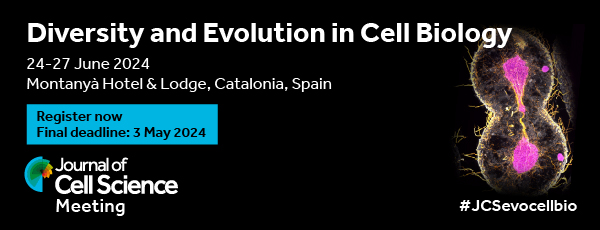Issues
-
Cover image
Cover Image

Cover: FLAG–syntaxin 17 (red), as well as endogenous syntaxin 17, is colocalized with mitochondria (green) in HeLa cells. It translocates to autophagosomes upon nutrient deprivation. Drosophila syntaxin 17 is predominantly present in the cytosol and translocates to autophagosomes upon starvation. C. elegans syntaxin 17, when expressed in HeLa cells, exhibits mitochondria-like localization, but does not translocate to autophagosomes. See article by S. Kato et al. (jcs258699).
- PDF Icon PDF LinkIssue info
RESEARCH HIGHLIGHTS
FIRST PERSON
CELL SCIENCE AT A GLANCE
Rhodopsins at a glance
Summary: Rhodopsins are photoreceptive membrane proteins that exist from prokaryotes to animals. Here, we review recent research on rhodopsins from a functional, molecular and optogenetic point of view.
RESEARCH ARTICLES
Low kindlin-3 levels in osteoclasts of kindlin-3 hypomorphic mice result in osteopetrosis due to leaky sealing zones
Summary: Osteoclasts with low kindlin-3 expression fail to form tight sealing zones, showing that kindlin-3 is not only crucial for osteoclast adhesion to the bone surface but is also essential for the organization of adhesion structures.
A cytosolic reductase pathway is required for efficient N-glycosylation of an STT3B-dependent acceptor site
Summary: We show that the NADPH-dependent cytosolic reductive pathway influences glycosylation efficiency in the endoplasmic reticulum, linking cellular glucose metabolism to secretory glycoprotein heterogeneity.
Unfolding is the driving force for mitochondrial import and degradation of the Parkinson's disease-related protein DJ-1
Highlighted Article: Several mutations in Parkinson's disease-related protein DJ-1 cause its mitochondrial import and degradation. We reveal that protein unfolding is the driving force for the import and degradation of DJ-1.
YAP1-mediated regulation of mitochondrial dynamics in IDH1 mutant gliomas
Summary: A novel role of YAP1 in regulating the generation of mitochondrial ROS, and in modulating the protective effect of TERT against oxidative stress, could provide insights for the development of new therapies to treat gliomas.
Evolutionary conservation of systemic and reversible amyloid aggregation
Summary: A functional and reversible form of amyloid aggregation is conserved across the eukaryotic domain and helps cells survive severe environmental stressors.
Cooperation of membrane-translocated syntaxin4 and basement membrane for dynamic mammary epithelial morphogenesis
Highlighted Article: We report a novel regulatory model for epithelial morphogenesis: a t-SNARE extruded in response to lactogenic hormone acts coordinately with basement membrane components to trigger mammary cyst formation.
Syntaxin 17, an ancient SNARE paralog, plays different and conserved roles in different organisms
Summary: Stx17 is an ancient SNARE paralog, but has been lost in multiple lineages. Because of diverse structures in the C-terminal tail, Stx17 plays different roles in different organisms.
Dynamic remodeling of ribosomes and endoplasmic reticulum in axon terminals of motoneurons
Highlighted Article: In motoneuron axonal growth cones, dynamic remodeling of the ER is coordinated through drebrin A-mediated actin and microtubule crosstalk and contributes to ribosome-dependent local translation in response to BDNF stimulation.
PQN-59 and GTBP-1 contribute to stress granule formation but are not essential for their assembly in C. elegans embryos
Summary: In contrast to human cells, where the UBAP2L and G3BP1 and G3BP2 proteins are crucial nucleators of stress granules, the C. elegans orthologs are not essential for this process in worms.
RETRACTION
CORRECTION
Introducing our new Editors

We welcome three new Editors to Journal of Cell Science - Robert Parton, Richa Rikhy and Simon Cook. You can read more about them in the Editorial from our Editor-in-Chief Michael Way.
2024 Journal Meeting 'Diversity and Evolution in Cell Biology'

Registration is open for our 2024 Journal Meeting Diversity and Evolution in Cell Biology, which aims to bring together evolutionary biologists and cell biologists investigating diverse aspects of cellular physiology. Final registration deadline: 3 May 2024.
Workshop: Physics of the Early Embryonic Cell Divisions

Early-career researchers interested in the roles of nuclear lipids, apply now for one of the ten funded places at this Workshop, which will take place 11-14 November 2024. Application deadline: 17 May.
Reasons to submit to Journal of Cell Science

There are many benefits to publishing in Journal of Cell Science - read more about why you should choose JCS or visit our submission page now.
Propose a new Workshop for 2026

We are now accepting proposals for our 2026 Workshops programme. We aim to be responsive to the community and open to novel initiatives, so if you have a new idea for a biological workshop that you feel would work well, please apply. Applications deadline: 19 July 2024.



